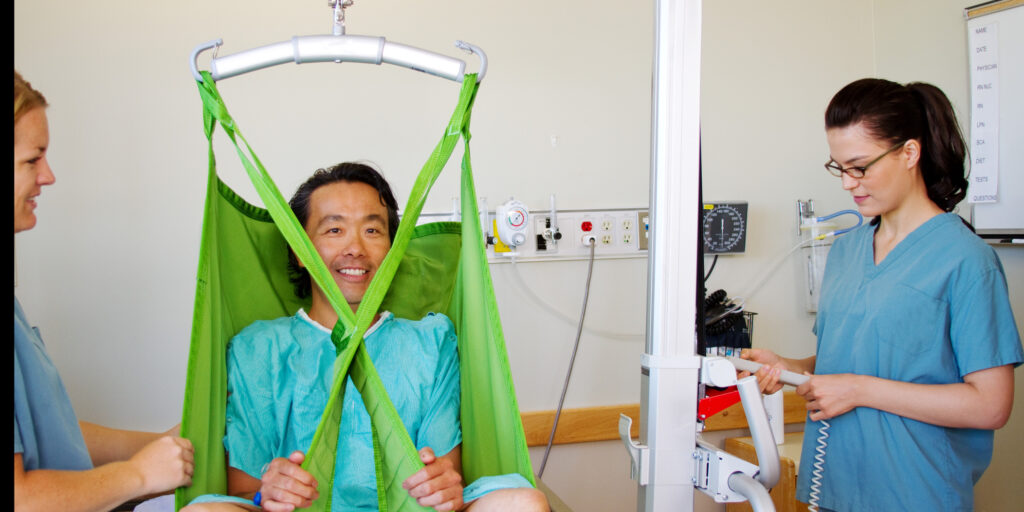
Hoyer Lifts and Beyond: Choosing the Right Lift Device
By Amy Bernstein | Wednesday, February 19, 2025
For those living with limited mobility from a neuromuscular disease or other disability, assisted transfers can be a big part of daily life. Many people who can’t stand and pivot or don’t have the upper body strength to use a sliding board independently require a transfer lift or lift system.
These devices generally have a supportive seat or sling attached to a sturdy arm or frame. They allow a caregiver to move a person from one place to another with minimal physical effort while letting the machine do the heavy lifting — a benefit important to the comfort and safety of both the individual using the lift and the caregiver helping to operate it.
Deciding what type of lift to use depends on the unique needs of each person and their caregivers.
Finding the right lift
If you’re in the market for a lift, here are three things to consider before making a decision:
1. Talk to an occupational therapist (OT) or physical therapist (PT).
An OT or PT will evaluate your needs by asking questions and offering guidance based on your situation.

Theresa Berner, MOT, OTR/L, ATP
“It’s ideal if the caregivers work together with a therapist to complete a trial of the equipment before buying it,” says Theresa Berner, MOT, OTR/L, ATP, an occupational therapist and Rehabilitation Clinical Manager at The Ohio State University Wexner Medical Center.
An OT or PT will generally start by asking, “What do you want this piece of equipment to do?” For example, a lift may be used to help a person get out of bed in the morning or get them to their feet if they fall. It may also help with transferring to different surfaces, such as a wheelchair or toilet. A lift can also help reposition a person in their wheelchair.
Next question: “In what environment do you want to use this equipment?” Is the lift needed at home, work, school — or all three? How big is the environment, and how much space is there to store the lift?
The choice of lift also depends on whether it will be used daily. You should also consider whether the lift is comfortable, provides dignity, and supports the person being moved.
It’s also important to know if the caregiver can comfortably operate the lift. Does the caregiver have enough upper-body strength for a manual lift? Can they get a sling around someone who has fallen on the floor? If the caregiver has weak knees, bad shoulders, arthritis, or other limitations in the joints or general strength, a power lift may be needed. Power lifts can be difficult to fund, but insurance will cover them in some cases.
2. Check your insurance coverage and funding options.
Each state’s benefits programs and private insurance companies are different, so it’s essential to learn about the rules where you live and understand your insurance coverage. Remember that there may be different guidelines for children and adults.
The healthcare system uses codes to identify each piece of durable medical equipment (DME). These codes are used to bill insurance and reimburse patients. New and unique pieces of equipment may not have the codes needed to process them through insurance. Insurance companies also pay set fees based on the codes, so if you ask for something the insurer considers an upgrade, it may be more expensive.
Insurance may not pay for more than one lift system, such as a stationary and a portable lift.
While most manual lifts can be covered by insurance or funded by Medicare or Medicaid with a prescription from your doctor, power lifts are trickier to get funded. Documenting that your caregiver has physical issues that don’t allow them to use a manual lift may help, but it does not guarantee that a power lift will get approved. “They are considered deluxe pieces of equipment and require special circumstances for approval,” Theresa says. “Some people ask if they can pay the difference between a manual and power lift, but many insurances do not allow for that request.”
When insurance does not cover a power lift, there may be other avenues:
- Your state’s Medicaid waiver program may have a budget for DME, such as a power lift or home modifications, including installing a ceiling or wall lift.
- A Vocational Rehabilitation Office will fund a power lift if it is necessary to find and keep a job.
- If a lift is needed at work, it may be considered a “reasonable accommodation” under the Americans with Disabilities Act (ADA), and the employer may be required or willing to pay for it. (If the employer doesn’t cover it, the price may be tax deductible under “unreimbursed business expenses” related to a disability.)
“Some families do fundraisers to assist with the cost of their lift,” Theresa says. MDA can also help locate lifts and other DME through in-kind partnerships and referrals to community resources.
3. Research dealers, prices, and sales.
Talk with local DME supply companies and ask them to keep you informed about sales. Looking for a used lift may be a good idea if you can find a lift that is in good condition and suitable for you.
Before you make a purchase, get an idea of what size, shape, and style of lift you need. “Working with an OT or PT can give you guidance on what lifts are suitable for your circumstances and what options may be safest,” Theresa says. “An OT or PT can also help you try out the equipment before you purchase it. Once a lift is purchased, it often cannot be returned.”
Types of lifts
Most lift companies offer a range of choices. Besides helping you accomplish your daily personal needs, many lifts can assist in physical therapy or recreational and leisure activities.
In this section, we’ll cover several types of lifts:
Floor lifts
A floor lift, also called a rolling lift, is a metal framework with a lifting mechanism and an extending arm. The term “Hoyer lift” is often used generically for this type of device, but Hoyer is a particular brand.
A floor lift can be wheeled from room to room and doesn’t need to be installed anywhere permanently. However, these lifts are large and difficult to maneuver in tight spaces like narrow hallways and small bathrooms. “They can also be difficult to store, and you should think of where you want to keep it,” Theresa says.
To transfer in and out of bed using a floor lift, you typically need several inches of clearance so the base can roll under the bed.
A floor lift can be manual or electric (powered by a rechargeable battery). Two main factors determine which kind of floor lift is right for you: ease of use and price.
With a hydraulic manual lift, such as the Hoyer Manual Hydraulic Lift, a caregiver operates the lifting action by pumping a lever. Some manual lifts use a hand crank instead of hydraulics.
The main reasons for getting a manual lift are the price, which ranges from about $600 to $3,000, and the fact that it is more likely to be covered by insurance. You can expect to pay anywhere from about $900 to $9,500 for an electric floor lift, such as the Diana lift from Horcher.
An electric lift is operated with the touch of a button and is less physically strenuous for the caregiver, although it can still be heavy to push from room to room.
Folding lifts
Want to take your floor lift with you on the go? Choose a lightweight, folding electric floor lift, such as the Protekt Take-Along from Proactive Medical, Advance-E 340 from Hoyer, or MoLift Smart 150 from etac. These lifts can be folded without using tools or separated into parts for transportation in a car trunk. Some companies offer a carrying case for air travel.
Expect to pay about $1,000 to $4,000 for a folding floor lift.
These smaller units may also be easier to maneuver in small spaces at home than standard floor lifts. However, they may not last as long with daily use and may be slightly less stable.
Ceiling lifts
A ceiling lift, also called an overhead lift, has a motorized lift device attached to a track mounted on the ceiling. A sling or harness is attached to the device, and it can move a person between points along the track. This type of lift works well in small spaces where a floor lift would be difficult to maneuver.
SureHands, Guldmann, and Horcher are a few of the companies that sell these systems. Ceiling lift systems are expensive (about $4,000 to $14,000); the cost depends on the length and configuration of the track and the ceiling structure.
Besides making it easier for a caregiver to maneuver, a major advantage of some ceiling lifts is that the lift user can operate it independently with a remote control if they can put the sling or body support on.
There are numerous options for ceiling lifts. The track system could be installed on the ceiling in one area or through multiple rooms. For example, the lift could take you from your bed through the bathroom doorway to the toilet or shower. Two- and four-way switches enable you to reach more places from the same track.
To go from room to room, the ceiling track must fit through the doorway and allow the door to close. An installer cuts into the doorframe or through the wall to accommodate the track.
Some companies have systems for room-to-room transfers that don’t require altering doorways, such as the Likorall R2R system from Liko. This involves having a lift unit on either side of a doorway and using a special transfer strap between them. Another option is having one lift unit that can be transferred from one track to another. The P440 from Prism Medical is a lightweight, portable lift system designed to be moved between tracks in different rooms. Room-to-room transfers require the assistance of a caregiver.
If your ceilings are vaulted or have obstructions such as heating or skylights, suspending the track from the ceiling is a way to keep it level. However, this method is typically more expensive because it is harder to install.
You might not be allowed to install a ceiling track system if you live in an apartment or dormitory. In that case, a freestanding track lift system may be the solution. These include the Easytrack from BHM Medical and free-standing rail systems from Guldmann. These systems can be set up in one area of a room, such as over the bed or in the bathroom.
Wall lifts
Like ceiling lifts, wall-mounted lifts are motorized systems that are convenient for tight spaces. However, they’re generally easier, faster, and less expensive to install, especially in bathrooms, where ceilings may have skylights or other obstructions.
You can expect to pay about $3,500-$8,000 to purchase and install a wall lift.
If you would like a wall lift in two rooms, such as the bedroom and bathroom, you can either get two separate wall lifts or put wall plates on each wall and transport the lift unit between the two rooms. The SureHands wall-to-wall lift system is made for this kind of transfer.
Of course, the first choice is more expensive but more convenient. The second option saves you money, but the lift itself is heavy (35 pounds), which may be difficult for a caregiver to transfer back and forth often.
Try equipment before you buy
The next step is trying out the equipment. You’ll find some types of lifts (mostly floor lifts) at your local DME dealer. If the dealer doesn’t have an OT or PT on staff, talk with your OT or PT about options that meet your needs and take time to try the equipment together so they can watch you try out lifts and provide guidance on the best fit.
One caveat: Most local DME dealers don’t have ceiling or wall lifts. You may need to call a company specializing in these lifts and ask to work with a local representative. They may be able to help identify where a trial piece of equipment is before you purchase one. Companies that install ceiling and wall lifts often also do home modifications. Some companies are associated with complex rehabilitation suppliers, and others exclusively work on home modifications.
“The ideal situation is to work with a therapist to try lifts to understand the ideal setup,” Theresa says. “Once you have an idea of what works best, you can begin exploring many options.”
Other considerations
To submit a claim to insurance, you will need a prescription for the lift device and a letter of justification that outlines the size and features. Each DME vendor has its own way of submitting claims and may require different information from you or your doctor. Be sure you understand what your DME dealer needs to submit your claim to insurance.
Medicaid waiver programs will require a denial from traditional Medicaid before considering funding the device. However, some DME companies do not process claims through Medicaid, which makes it challenging to use Medicaid waiver funding. If this is the case, work with your Medicaid waiver service coordinator. They may be able to help navigate around this issue.
Don’t forget to look at slings, which are sold separately from lift devices. Many lift companies carry a variety of slings that offer different levels of support and mobility for the lift user. A standard sling has a seat and back for body support. Head support can be added if needed. A hygiene sling with a large cutout makes transferring to the toilet more convenient. Slings made for bathtub and pool transfers are made of a quick-drying mesh material. Some lifts may use other types of harnesses or supports.
The right lift is out there. By following the advice of an OT or PT, consulting with your insurance and DME dealers, and doing careful research, people with neuromuscular diseases and caregivers will be able to transfer from one place to another with more ease.
Lift Resources
Lift and DME dealers
1800Wheelchair.com Patient Lifts & Slings
etac Patient Handling (Molift)
Horcher Medical Systems Patient Lifts
Used equipment
Next Steps and Useful Resources
- MDA Access Workshop: Access to Equipment and Assistive Devices
- MDA Learning Series: Equipment and Assistive Technology
- Quest Blog: Durable Medical Equipment Support Through MDA
- Find more tips and equipment for safe, easy transfers
- Read 7 Essential Tips for Family Caregivers to Avoid Common Injuries
- Stay up to date on Quest content! Subscribe to Quest Magazine and Newsletter.
TAGS: Caregiving, Equipment and Assistive Devices, Featured Content, Insurance
TYPE: Blog Post
Disclaimer: No content on this site should ever be used as a substitute for direct medical advice from your doctor or other qualified clinician.




